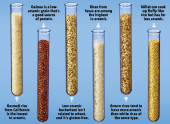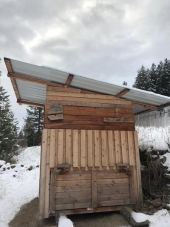





QuickBooks set up and Bookkeeping for Small Businesses and Farms - jocelyncampbell.com









[img]http://i109.photobucket.com/albums/n52/havlik1/permie%20pics2/permiepotrait3pdd.jpg[/img]
"One cannot help an involuntary process. The point is not to disturb it. - Dr. Michel Odent









My books, movies, videos, podcasts, events ... the big collection of paul wheaton stuff!









[img]http://i109.photobucket.com/albums/n52/havlik1/permie%20pics2/permiepotrait3pdd.jpg[/img]
"One cannot help an involuntary process. The point is not to disturb it. - Dr. Michel Odent








[img]http://i109.photobucket.com/albums/n52/havlik1/permie%20pics2/permiepotrait3pdd.jpg[/img]
"One cannot help an involuntary process. The point is not to disturb it. - Dr. Michel Odent










Russian households (inclusive of both urban and rural) collectively grow 92% of country's potatoes on their garden-plots, the size of which is typically 600 square meters [0.15 acres] for urban households, and typically no more than 2500 square meters [0.62 acres] for rural households
QuickBooks set up and Bookkeeping for Small Businesses and Farms - jocelyncampbell.com




There is nothing permanent in a culture dependent on such temporaries as civilization.
www.feralfarmagroforestry.com














 ) even if we wanted to. There are infinite variables: knowledge and skill sets, experience, resources, passions, etc. that go into each individual's home, garden(s) and permaculture make up.
) even if we wanted to. There are infinite variables: knowledge and skill sets, experience, resources, passions, etc. that go into each individual's home, garden(s) and permaculture make up. QuickBooks set up and Bookkeeping for Small Businesses and Farms - jocelyncampbell.com




There is nothing permanent in a culture dependent on such temporaries as civilization.
www.feralfarmagroforestry.com










QuickBooks set up and Bookkeeping for Small Businesses and Farms - jocelyncampbell.com




Leah Sattler wrote:
paul- does he take into account the cost of that land to grow your own food?
My books, movies, videos, podcasts, events ... the big collection of paul wheaton stuff!




Leah Sattler wrote:
I grow as much as I can to avoid the grocery store stuff. also have to take into account another intangible, one of the few positive ones of "store buying" -variety. I am not prepared nor do I have any desire to live on nuts and wild greens and seasonal fruit and I like bread and potatoes and rice and beans none of which can be produced as a perrenial succesfully from what I know.
Iwant to address another "intangible". free time. farming has allowed the arts to flourish. it has enabled people to become educated and to ponder the great mysteries of life. dare I say it has brought us out of the "wild".
My books, movies, videos, podcasts, events ... the big collection of paul wheaton stuff!










QuickBooks set up and Bookkeeping for Small Businesses and Farms - jocelyncampbell.com








My books, movies, videos, podcasts, events ... the big collection of paul wheaton stuff!








My books, movies, videos, podcasts, events ... the big collection of paul wheaton stuff!








TCLynx








TCLynx








TCLynx











 And who have the money, and probably understand all the intangibles and health values, but just need a bit of an analytical nudge to convince them food plants are worth the expense.
And who have the money, and probably understand all the intangibles and health values, but just need a bit of an analytical nudge to convince them food plants are worth the expense. QuickBooks set up and Bookkeeping for Small Businesses and Farms - jocelyncampbell.com












TCLynx









 So I guess I could say I save on gym memberships (as though there is something like that here!)
So I guess I could say I save on gym memberships (as though there is something like that here!)Sustainable Plantations and Agroforestry in Costa Rica








As stated below, if you are patronizing middle class non- organic grocery stores versus growing your own then NO WAY is it cheaper. A human body cannot compete with a tractor. Manure cannot compete with petroleum fertilizer. Once you pay for garden fencing and the acreage in the suburbs, you've lost money compared to the guy who shops at Safeway.
My books, movies, videos, podcasts, events ... the big collection of paul wheaton stuff!




Fred Morgan wrote:
The key is to go for what grows with minimum effort. Most people though will grow what they like to eat, which may well end up being more work intensive.
TCLynx








find religion! church
kiva! hyvä! iloinen! pikkumaatila
get stung! beehives
be hospitable! host-a-hive
be antisocial! facespace




"the qualities of these bacteria, like the heat of the sun, electricity, or the qualities of metals, are part of the storehouse of knowledge of all men. They are manifestations of the laws of nature, free to all men and reserved exclusively to none." SCOTUS, Funk Bros. Seed Co. v. Kale Inoculant Co.

|
Yeah. What he said. Totally. Wait. What? Sorry, I was looking at this tiny ad:
Free Heat Movies! Get 'em while it's Cold!
https://www.stoves2.com/Wood-Burning-Stoves
|




